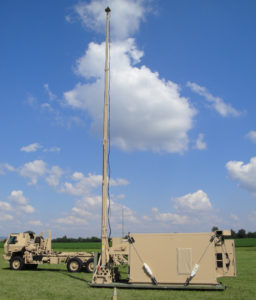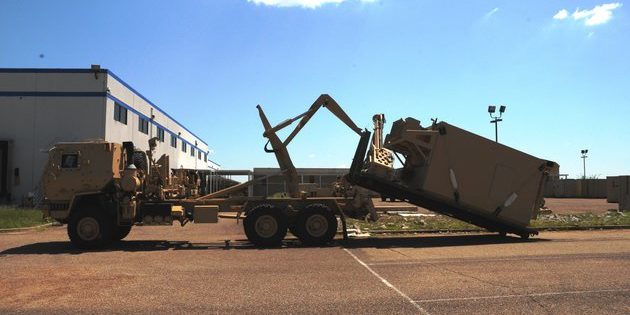Overview
Developed by Northrop Grumman for the U.S. Army, the Integrated Air and Missile Defense Battle Command System (IBCS) is a command-and-control (C2) capability that integrates air and missile defense systems to eliminate stovepipes and allow warfighters to use any sensor or weapons to achieve mission objectives.[1] Using IBCS, soldiers can perform surveillance, identification, weapon management, and engagements functions and collaboratively plan and execute joint engagements of air and missile threats.[2] The system is capable of incorporating current and future air and missile defense systems, sensors, weapons and battle management command, control, communications, and intelligence systems into a fully integrated network.[3] According to Northrop Grumman, the system enables “any sensor, best shooter” operations to maximize defense capability, optimize limited resources and provide flexibility on the battlefield.[4]

Deployed IBCS engagement operations center shelter
Integration provided by IBCS allows the department to invest in new capabilities in a much more fiscally responsive way by investing in sensors or weapons that can fill capability gaps without having to buy complete weapon systems. IBCS enables common mission command across Air Defense Artillery, other U.S. Army forces, and other integrated air and missile defense (IAMD) forces.[5] In addition to providing the means for integrating U.S. IAMD assets, IBCS also establishes the means for connecting complementary and coalition systems for joint and cooperative multinational missile defense.[6]
The system provides wider area surveillance and wider area protection because it integrates sensors and interceptors as opposed to simply linking them.[7] This also offers the flexibility for deploying smaller force packages. The C2 system is ideal for integrating air and missile defense systems in fast-paced and dynamic threat environments, allowing for enhanced capability against numerous and diverse air and missile threats.
IBCS is integrating Patriot air and missile defense systems and the Sentinel sensor. IBCS will integrate soon with the Terminal High-Altitude Area Defense (THAAD). The system was also designed to incorporate other sensor systems such as Surface-Launched Advanced Medium Range Air-to-Air Missile (SLAMRAAM) and Joint Land Attack Cruise Missile Defense Elevated Netted Sensor (JLENS), but these programs have since been discontinued.[8]
Capabilities[9]
- Use composite track data from multiple sensors to create a single, integrated air picture
- Acquire, classify, identify, assign, engage, and kill incoming threats systems
- Select the best available weapon for the threat
- Create task forces and teams that are flexible, scalable, and adaptable to rapidly changing situations and environments
- Allows IAMD soldiers to engage threats more intuitively rather than being restricted by particular unit capabilities
Current Developments
In April 2016, the U.S. Army successfully conducted a dual engagement flight test using IBCS, validating the system’s ability to manage multiple threats simultaneously.[x] The system is scheduled to reach initial operational capability in 2019, however, in August 2016 the system’s production was put on hold because of software issues. A report in February 2017 claimed that software bugs have caused continued delays for the IBCS program, and the Army has not yet determined how delayed the program is.
Recent News
Timeline
February 2017: A report indicated that the IBCS program was delayed because of software bugs.
April 18, 2016: The U.S. Army successfully conducted a dual engagement flight test using IBCS.
November 16, 2015: The U.S. Army and Northrop Grumman conducted an intercept test using IBCS for command-and-control. During the test, IBCS integrated Sentinel and Patriot radars with a Patriot PAC-3 interceptor to destroy a cruise missile target.[xii]
May 28, 2015: The U.S. Army and Northrop Grumman conducted an intercept test using IBCS to destroy a target ballistic missile. Two Patriot launchers and a Patriot radar were connected using IBCS’s integrated fire control network during the missile intercept.[xiii]
September 23, 2013: Northrop Grumman and the U.S. Army incorporate Patriot and Sentinel capabilities into IBCS.[xiv]
November 15, 2011: IBCS demonstrated its integrated command capabilities when in exchanged date from sensors and systems from the U.S. Army, Navy, Air Force, and Marine Corps to form a single integrated air picture.[xv]
April 26, 2010: The U.S. Army and Northrop Grumman completed an Interim Design Review for IBCS, allowing the command system to enter the design phase.[xvi]
August 17, 2010: The first battery engagement operations center for IBCS was delivered to the U.S. Army.[xvii]
March 31, 2010: Northrop Grumman creates a laboratory-based prototype of IBCS.[xviii]
January 11, 2010: Northrop Grumman wins $577 million Army Integrated Battle Command System contract.[xix]
Sources
[1] http://www.northropgrumman.com/Capabilities/IBCS/Documents/IBCS_datasheet.pdf
[2] http://www.northropgrumman.com/Capabilities/IBCS/Documents/IBCS_datasheet.pdf
[3] http://www.northropgrumman.com/Capabilities/IBCS/Documents/IBCS_datasheet.pdf
[4] http://www.northropgrumman.com/Capabilities/IBCS/Documents/Breaking-Defense-Jun2015.pdf
[5] http://www.northropgrumman.com/Capabilities/IBCS/Documents/IBCS_datasheet.pdf
[6] http://www.northropgrumman.com/capabilities/ibcs/Pages/default.aspx
[7] http://www.northropgrumman.com/capabilities/ibcs/Pages/default.aspx
[8] http://www.defenseindustrydaily.com/all-together-now-integrating-the-us-armys-disparate-air-and-missile-defenses-06090/
[9] http://www.northropgrumman.com/Capabilities/IBCS/Documents/IBCS_datasheet.pdf
[10] http://breakingdefense.com/2016/04/missile-defense-brain-multi-tasks-army-ibcs-kills-cruise-ballistic-missiles/
[11] http://www.janes.com/article/65519/pacom-chief-eyes-coastal-defence-artillery-for-south-china-sea

